Sauropterygia: Placodontia
Taxa on This Page
- Placodontia X
- Placodus X
- Psephoderma X
- Cyamodontoidea X
- Cyamodus X
- Henodus X
- Placochelyidae X
- Placochelys X
Evolutionary relationships
Like the thalattosaurs, hupehsuchians, hevetticosaurs, omphalosaurs, and ichthyosaurs, the placodonts are one of those specialsed groups of Triassic marine reptiles that are hard to place on the reptilian phylogenetic tree. Both a return to life in the sea, and specialised habit, conspire to create evolutionary forms very different from their ancestors. Who would have guessed for example that whales are descended from even-toped ungulates? For the most part, the consensus has been that they are diapsids, perhaps related to, but distinct from, the Sauropterygia, and being included with them, for example by Colbert and Romer, in the subclass Euryapsida. German Palaeontologist Oskar Kuhn in contrast gave them a subclass all of their own, considering they did not show clear relationships with any established reptile group (Kuhn 1969). In the last few decades however a number of systematists have firmly restablished the placodonts within the duiapsida, this time within the Sauropterygia, the only controversy being whether they are basal to (e.g. this cladogram) or more derived than (e.g. Storrs 1993 fig 3) the Pachypleurosaurs. In the view of one of the authors (MAK), the Pachypleurosauridae are a paraphyletic assemblafge (i.e. Pachypleurosauridae cladistically defined = Sauropterygia) so the question becomes irrelevant anyway.
Significantly, Placodonts were metabolically active, as they have the most advanced have the most advanced fibrolamellar bone tissue within the Sauropterygia (Klein 2010 p.23). This implies they may not have been as basal as they are portrayed in most sauropterygian phylogenetic hypotheses. Rather, as with the Mesosauria, which are placed by cladistic analysis at either the base of the Anapsida or the base of the Amniota, their highly specialsed nature and lack of easily recognisable shared characteristics means it is hard to know where they branched off. One possibility is that they are derived from fast-growing and hence physiologically more advanced, if otherwise morphologically primitive, pachypleurosaurs of the Anarosaurus type. MAK111103
Triassic sea cows
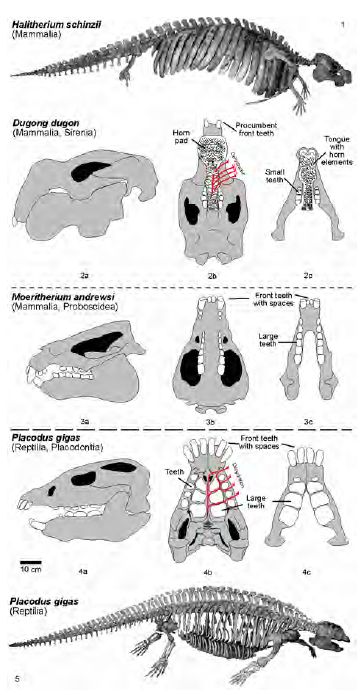
Convergent development in 1. Halitherium from the Oligocene of Europe, 2. the extant Dugong, 3. the Eocene Moeritherium, and 4-5. Placodus from the Middle Triassic of the central European Germanic Basin. (Both Placodus and Halitherium are about 2.5-3.0 meters in length). Diagram from Diedrich 2011, Copyright © 2011 SciRes. |
For as long as we've read about placodonts, one thing is always agreed upon. They used their large flat teeth to eat hard shelled food. For example, Wikipedia says: "Their diet consisted of marine bivalves, brachiopods, and other invertebrates. They were notable for their large, flat, often protruding teeth which they used to crush molluscs and brachiopods, which they hunted on the sea bed (another way in which they were similar to walruses). The palate teeth were adapted for this durophagous diet, being extremely thick and large enough to crush thick shell." It's probably not worth chasing up further refrences, though if you are curious a simple google search with the appropriate keywords should do the trick. This is not the case with all taxa - Darren Naish for example has written a fascinating post on Henodus the filter feeder. But Henodus was a late abbarent genus, remarkable for its toothlessness.
Descriptions
Placodontia: placodonts > plesiosaurs) Paraplacodus, Placodus, Henodus.
Marine or amphibious, short (1-3m), very-wide walrus- or sea cow like bodies, relatively unspecialized for aquatic life. Massive consolidated skull; large flat teeth or plates; buck-toothed (procumbent) premaxillary teeth; neck short; pachyostosis; centra deeply amphiocoelous; long neural & transverse processes; ribs massive, giving body rather square outline; tail short; limbs and pectoral girdles poorly ossified; pelvis plate-like; dermal plate armor common, some with epidermal scutes; molluscivores.
Links: Placodonts by Darren Naish, Oceans of Kansas Best on the Web; Wikipedia; Lecture 9 - Triassic: Moenkopi, Karroo, Ischigualasto; Paleontology and Geology Glossary: Pl to Po (very basic coverage); Placodonts (very basic coverage). Checked MAK111102
Note: related to turtles, according to some. After studying pachypleurosaurs, we're a lot more sympathetic to this point of view. ATW061216, rev'd ATW080328.
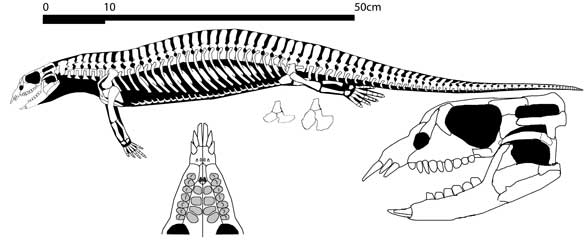
Paraplacodus P. broilli Peyer 1931
Phylogeny: Basal Placodontia
Size: length 1.5 meters
Comments: Although a good ancestral type from which more advanced placondonts could be derived, this primitive placodont was already a highly specialised animal. MAK111102
Graphic: © David Peters Reptile Evolution, reproduced with permission.
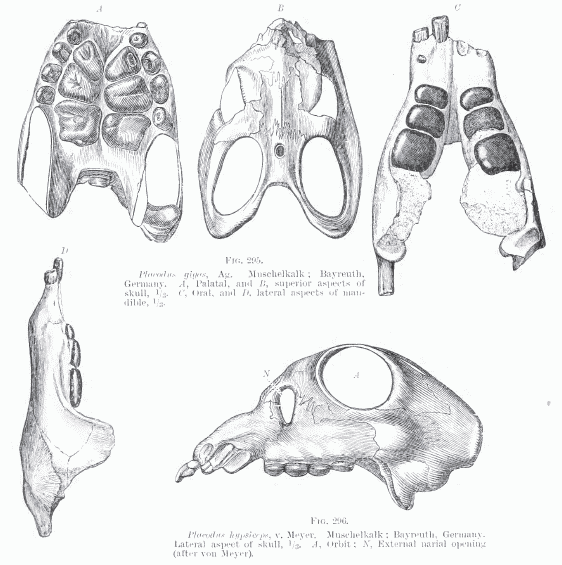
Placodus Agassiz
Phylogeny: Placodontia : Cyamodontoidea + *.
Skull not much longer than broad, superiorly arched, the snout somewhat produced. Premaxillae and symphysis of lower jaw with eylindro-conical incisors. On either side of the palate and on the dentary are three large rectangular pavement teeth ; maxillae with a single series of depressed, conical teeth. Detached teeth are abundant in the Muschelkalk of Southern Germany and France, rare in the Wellendolomite and Alpine Keuper - Zittel, 1902, Text-book of Palaeontology, vol.2 pp.187-8 (Public domain)
Size: length to 2 metres
Comments: this is the classic placodont, a stocky body, long tail, short neck, short, heavy, dome-like skull, and distinctive large pavement like teeth. It is generally believed that the teeth were an adptation to a diet of shellfish, but Diedrich 2011 presents a strong case that they were actually an adaptation to eating seaweed. There is already the beginning of the armour that reaches such prominance in more advanced members of the group. Quoting Wikipedia: "The vertebral processes of Placodus dove-tailed into each other and were firmly connected, so that the trunk was rigid. The abdomen was covered with a special armor formed of the bent, right-angled abdominal ribs. Equipped with dense bones, heavy belly ribs, and a row of bony knobs above the backbone, Placodus was a heavily built and negatively buoyant creature that would have had no trouble staying on the seafloor to feed. This body armour would have offered protection from predators as well, but would have also hampered mobility on land, making Placodus slow and clumsy out of water." MAK111101
Image: Zittel, Text-book of Palaeontology
Cyamodontoidea
Middle to Late Triassic of Europe
Phylogeny: Placodontia : Placodus + * : (Cyamodus + Henodus) + Placochelyidae
Comments: The higher placodonts, defined by more extensive armour and details of the skull. Reduced or absent premaxillary teeth and a turtle-like carapace composed of interlocking scutes -
References: Rieppel 2001; Naish, Placodonts
Cyamodus , v. Meyer. C. rostratus, Miinster sp
Phylogeny: Cyamodontoidea : Placochelyidae + (Henodus + *).
Skull triangular, snout much compressed. Supratemporal vacuity elongated oval, nearly three times as large as the orbits, which are placed in anterior third of the skull. Anterior nares small, separate, nearly terminal. On either side of the palate are placed two or three rounded or elliptical-crushing teeth, the hindmost at least twice the size of the anterior. - Zittel, 1902, Text-book of Palaeontology, vol.2 p.188 (Public domain)
Henodus H. chelyops, Huene 1936
Late Triassic of Gipskeuper (Early Carnian) of Tübingen, southern Germany.
Phylogeny: Cyamodontoidea : Placochelyidae + (Cyamodus + *.)
Skull broad and flat rostrum short; maxillary without tooth plates but with deep grooves (supporting baleens); palatine with single posterior tooth plate; upper temporal fenestra vestigial or absent (Rieppel 2001)
Size: overall length of about 1.2 meters
Comments: The only known non-marine placodont, it inhabited brackish or possibly freshwater lagoons, and may have fed on fishes and crustaceans as well as molluscs. As with the Ladinian Placochelys, it was a member of the Placodonta that had evolved to look like turtles, with a broad armoured carapace. The back and belly were covered with an armour of irregular, many-sided bony plates, the whole being completely covered with horn. The square toothless snout was equipped in life with a strong horny beak, another parallel with a modern turtle. Originally it was considered to be an advanced species, but recent research indicates that Henodus may actually represent a primitive form, and its late appearance in the fossil record explained by the fact that it was restricted to a peculiar environment that is not preserved in older rocks of the same region. [Rieppel and Zanon 1997).
Amazingly, this animal was actually a filter feeder, as Darren Naish explains. To quote:
"the rediscovery in the 1990s of striations within the jaw grooves (originally reported in 1936) indicate that Henodus had baleen-like material fringing its jaws. Furthermore, long overlooked is that the premaxillae support a ventrally projecting flange with a sharp cutting edge. Even more surprising is that this cutting edge exhibits a row of toothlike denticles along its anterior surface. When considered together and compared with the feeding adaptations of turtles, these features suggest that Henodus was a filter feeder that employed depression of the heavy lower jaw and expansion of the throat to suck in food particles. It may have engulfed swimming invertebrates, filtered burrowing forms out from the substrate, or used the premaxillary flange and denticles to scrape algae off rocks or to cut off pieces of other kinds of aquatic vegetation. Clearly, reappraisal of this bizarre placodont has revealed hitherto unsuspected diversity in the ecology of Mesozoic marine reptiles."
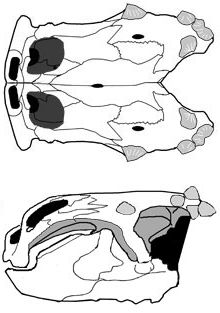 |
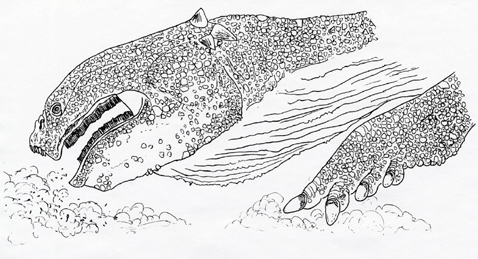
|
| The strange skull of Henodus. Note how far forward the eyes are. The spikes on the skull are reminiscent of ankylosaurs. Drawing copyright © David Peters, Reptile Evolution. See Darren Naish's Tetrapod Zoology page (right)for a close up photo and more detailed drawing |
life restoration of Henodus, drawing copyright © Darren Naish, Tetrapod Zoology. At first it's hard to see the eyes, because we're used to them being positioned towards the back of the head. In Henodus they are over the front of the jaw, close to the nostrils |
Links: Henodus, filter-feeding Triassic marine reptile; Wikipedia, Dinosaur fact net, Reptile evolution, About com (basic info), Checked MAK111102
References: Dixon et al 1988, Kuhn 1969, Naish 2000
,
Placochelyidae Romer, 1956
Phylogeny: Cyamodontoidea : (Cyamodus + Henodus) + * : Placochelys + Psephoderma
Comments: intrerpreted as reptilian rays, with flattened bodies and very long, slim tails (Mazin & Pinna 1993, ccited in Naish); narrow triangular skulls, pointed and toothless beaks, extensive, turtle-like carapaces; Naish, Placodonts
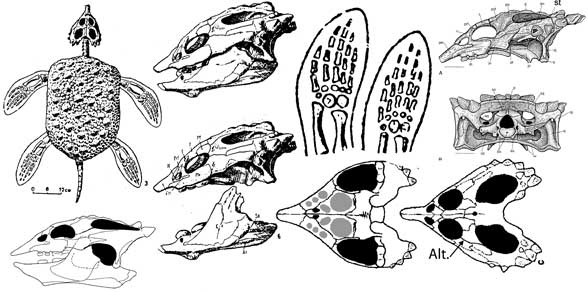
Placochelys P. placodonta Jaeckel 1902
Phylogeny: Cyamodontoidea : (Cyamodus + Henodus) + * : Placochelys + Psephoderma
Size: 90 cm
Shell highly convergent with turtles. Three small, rounded teeth on each maxilla
Comments: intrerpreted as reptilian rays, with flattened bodies and very long, slim tails (Mazin & Pinna 1993, ccited in Naish); narrow triangular skulls, pointed and toothless beaks, extensive, turtle-like carapaces; Naish, Placodonts
Graphic: David Peters Reptile Evolution, adapted from Kuhn 1969.
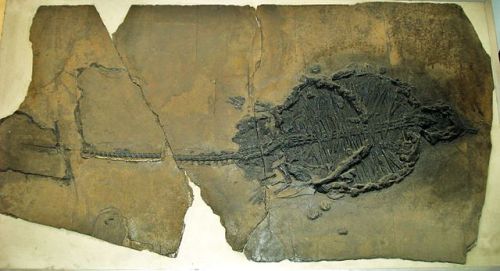
Psephoderma
Late Triassic (Latest Middle Norian ( Calcari di Zorzino of Northern Italy) to Rhaetian) of Tethys Europe
Phylogeny: Cyamodontoidea : (Cyamodus + Henodus) + * : Placochelys + Psephoderma
Size: Norian specimens are at least 50% longer in linear dimensions than Rhaetic forms (the largest complete specimen is 180 cm long, but isolated teeth indicate it grew larger) so it is possible that these might be a different subspecies or even species.
two teeth on each maxilla, the posterior (rear) one larger
Comments: ray-analogue; the body is very broad and flattened. The discoidal carapace armour is in two parts, making the animal more mobile, there is a long thin tail, which does not seem to have been used in swimming. At least two species are known: the Tethyan P. alpinum and P. anglicum from the Rhaetian of England.
Graphic: photo by Ghedoghedo of Psephoderma alpinum, at the Museo di Storia Naturale di Milano Wikipedia, GNU Free Documentation/Creative Commons Attribution
Links: Psephoderma by Dr Silvio Renesto Best on the Web; Wikipedia; Psephoderma and nothosaurid by Kahless ; Paleo sculpture by Hirokazu Tokugawa; Paleobiology database, Prehistoric blog - Psephoderma (Polish) Checked MAK111102
revised ATW080328, checked ATW030715; new page MAK111102
Using this material. All material by ATW is public domain and may be freely used in any way (also any material jointly written by ATW and MAK). All material by MAK is licensed Creative Commons Attribution License Version 3.0, and may be freely used provided acknowedgement is given. All Wikipedia material is either Gnu Open Source or Creative Commons (see original Wikipedia page for details). Other graphics are copyright their respective owners





